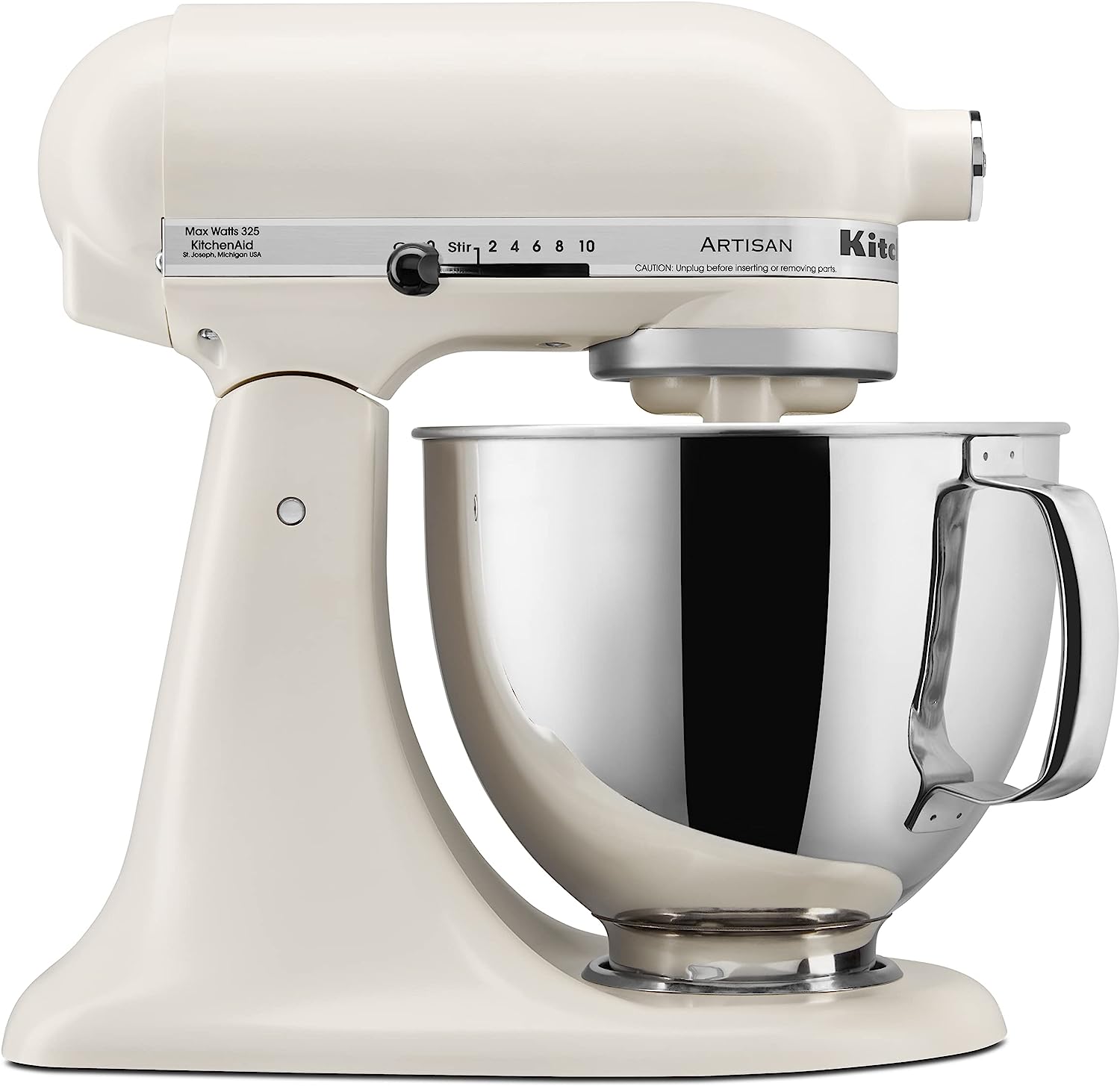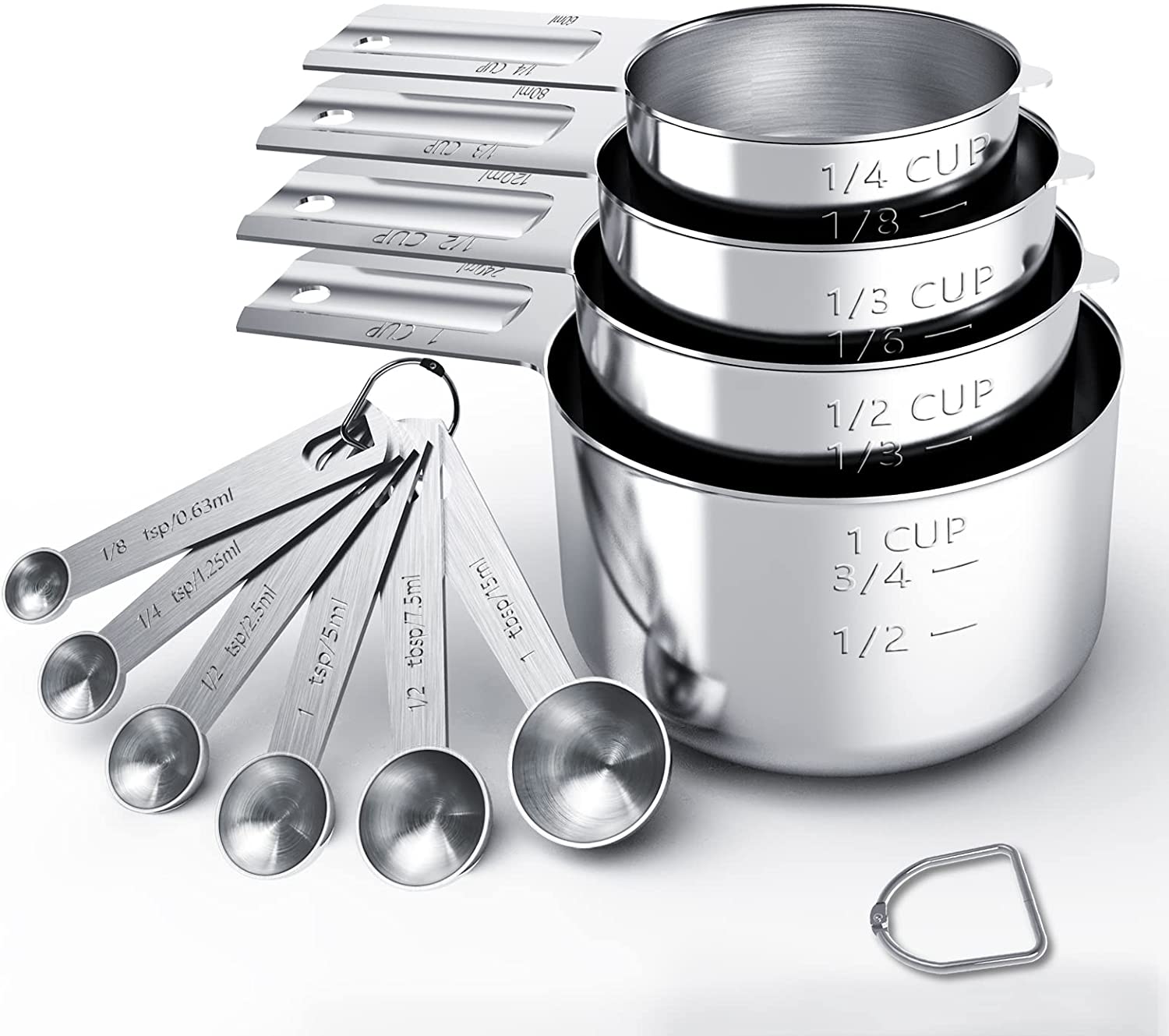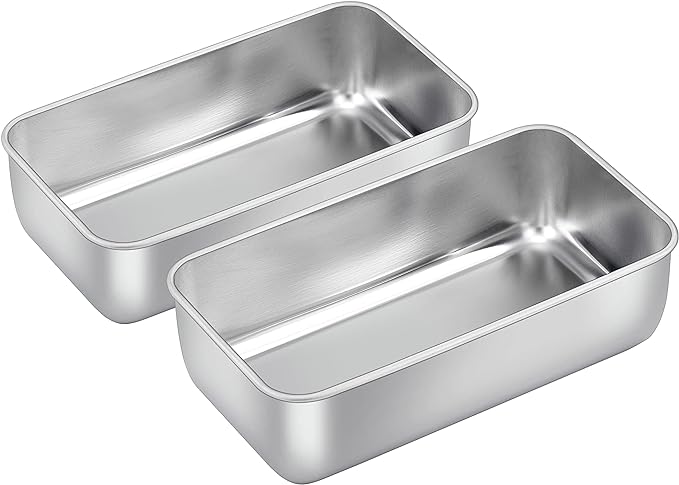Cinnamon Raisin Sourdough Bread Recipe
This Sourdough Cinnamon Raisin Bread is an easy, low maintenance sourdough bread recipe that yields the best loaves of a soft sourdough treat. Sweet cinnamon sugar and juicy raisins swirled in soft white bread is super delicious and nostalgic.
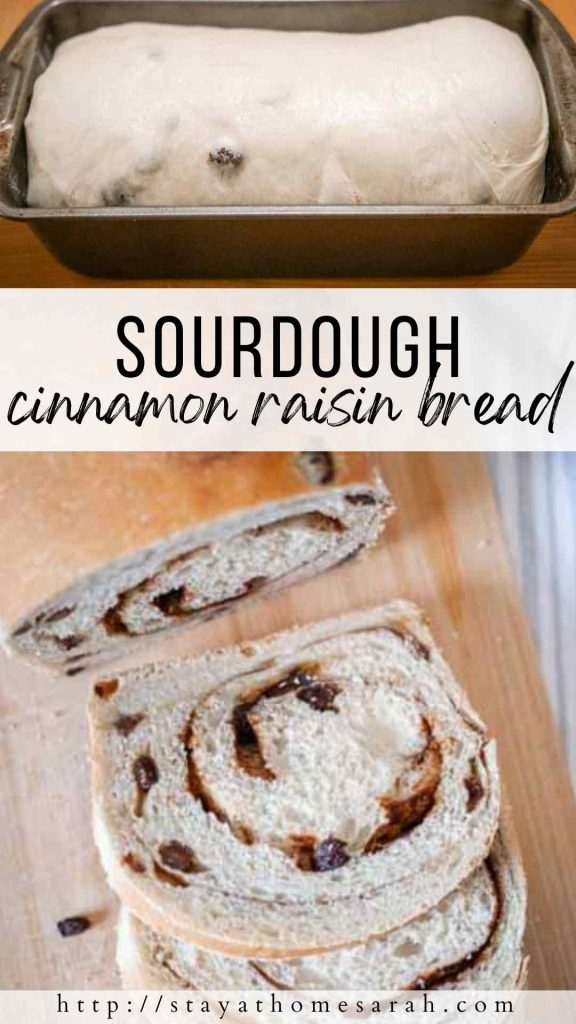
This post contains affiliate links. As an Amazon Associate, I receive a small commission at no extra cost to you. Read my full disclosure here.
Cinnamon raisin toast is one of those childhood treats that just reminds you of Grandma’s house. I love finding ways to make these classic favorites just a bit healthier. The easiest way to do that is to convert them to sourdough! Making bread the traditional way, by fermenting or soaking the grains, breaks down the gluten making the bread easier to digest. And it adds a delicious layer of tangy sourdough flavor.
There are a few sourdough recipes that I make weekly – Sourdough Dutch Oven Bread, Sourdough Pancakes, Soft Sourdough Sandwich Bread, and this Sourdough Cinnamon Raisin Bread. My kids love the sandwich bread, and they especially love when I upgrade it to this Cinnamon Raisin Bread recipe or Sourdough Cinnamon Rolls. Nothing beats a soft, fluffy white bread swirled with cinnamon and sweet raisins. It’s the best treat right out of the toaster with melty butter spread over the top.
In this post, you’ll find step-by-step instructions to make delicious Sourdough Cinnamon Raisin Bread.
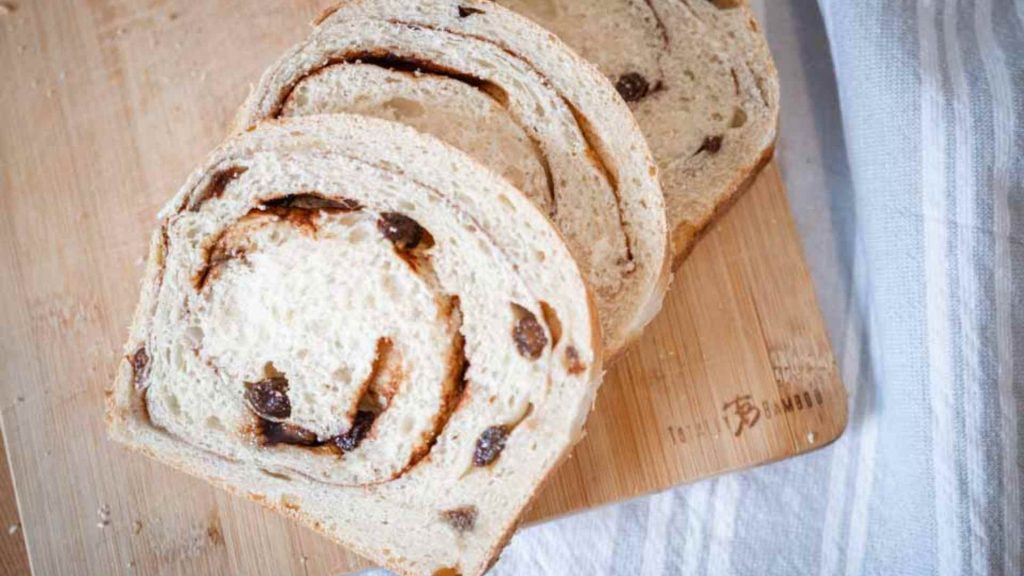
what is sourdough?
Let’s talk about sourdough. Sourdough bread is bread that has been leavened naturally, by naturally occurring yeast in the form of a sourdough starter as opposed to using commercial yeast or a chemical leavening agent such as baking powder or baking soda.
what is a sourdough starter?
A sourdough starter is a live fermented culture of fresh flour and water. Once combined, the culture will begin to ferment and cultivate the natural yeasts found in our environment. A small portion is added to your bread dough to make it rise, assuming you are using a healthy and active starter. Commercial yeast is not required.
This makes sense when you understand that natural “wild” yeast is all around us. It can be found in a bag of flour, in the air, on your hands etc. When we are able to capture that yeast and nurture it enough to grow and strengthen, we can add it to many different kinds of recipes. You can make your own sourdough starter at home by following these instructions: HERE…. or you could purchase a starter that has been dehydrated at it’s strongest state and rehydrate it at home. This is the method I recommend.
I suggest starting with a dehydrated sourdough starter that you rehydrate and activate in your own kitchen. This way, you are guaranteed to have a strong and active starter from the start. This will give you the confidence to begin sourdough baking right away. Once you have the hang of sourdough baking and know what to expect, then you can attempt to create your own starter. This way, you will be well acquainted with a healthy starter and know how to troubleshoot if issues arise.
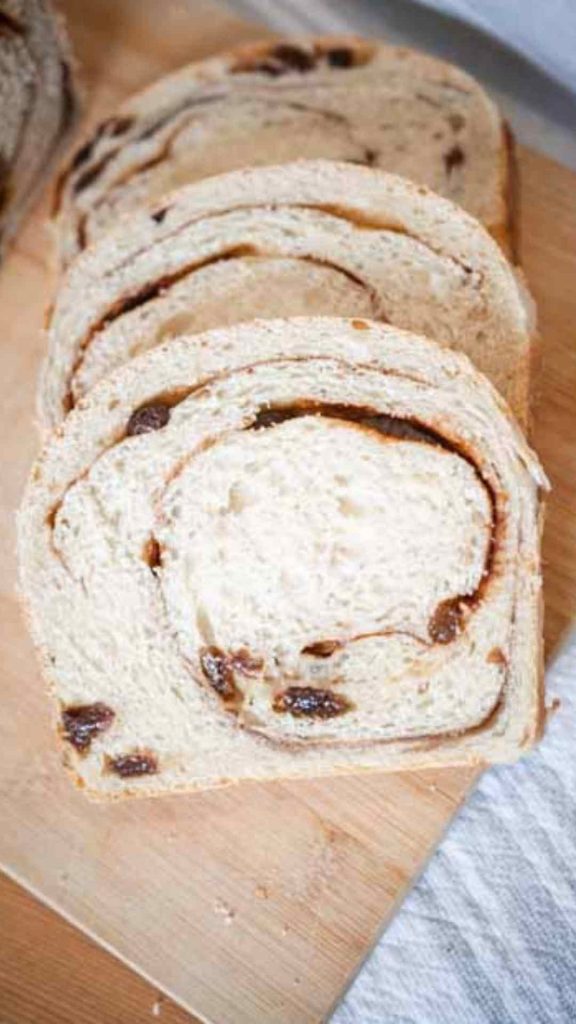

ingredients
Bread:
- Bread flour: organic, if possible
- Butter: salted or unsalted work just fine
- Honey or maple syrup: just a little bit to give the sourdough bacteria a boost
- Salt: Redmond Real Salt is my favorite
- Filtered water: we LOVE our Berkey
- Sourdough starter: active and bubbly
- Raisins
Filling:
- Brown sugar
- Cinnamon
equipment
What if I don’t have a stand mixer? You can easily make this recipe without a stand mixer. After mixing and resting the dough, knead by hand on a lightly floured work surface for 8-10 minutes, or until the dough has become glossy and smooth and passes the windowpane test.
What size loaf pan should I use? A 9×5 inch loaf pan is best. 8.5×4 inch work well too, but it will produce a taller loaf of bread.
Do I have to use bread flour? You do not have to use bread flour, you can sub the same amount of all purpose flour instead.
Is there any way to make this bread faster? Remember that temperature controls the time when it comes to sourdough. A warmer environment will help speed up the process if you’re hoping for a same-day bread. I include more details about how to do this later in the post.

how to make homemade cinnamon raisin bread
mix the dough
In the bowl of a stand mixer, add melted butter, warm water, active sourdough starter. sugar, salt and half of the flour. Mix with the paddle attachment until all of the ingredients are well combined. Add the rest of the flour and the raisins and switch to the dough hook. Knead on low speed for 7-8 minutes, or until the dough is glossy and smooth and passes the windowpane test. The dough should feel soft and slightly sticky, but not too sticky to handle. It will be quite sticky when you first begin kneading, but will become less sticky as it comes together. After 7-8 minutes of kneading, if it is too sticky to handle, add some more flour (just a little bit at a time).
bulk rise
This is the first rise or the “bulk fermentation.” Bulk fermentation is the longest period of time during the fermentation process. Put all of the dough into a buttered bowl and cover with plastic wrap or a damp towel. Leave the dough at room temperature overnight or for 10-12 hours. The dough is ready when it has doubled in size.

shape the dough
The next morning, spread melted butter into a loaf pan. To shape the dough, roll it out into a large rectangle. Stretch the sides as far as you can without breaking or tearing, and press the dough into a long rectangle. Mix the filling ingredients and spread evenly over the rectangle. Then starting at the short end, roll the dough up into a log. Pinch the seam closed. Tuck the ends underneath so only the smooth, round top of the dough is exposed. Place the dough into a buttered loaf pan seam side down. Cover with a damp towel and let the dough rise again.
second rise
Now the dough needs to rise again. The second rise can take anywhere from 3-6 hours depending on the temperature of your house. If it’s warm, it will rise more quickly. The dough is ready to bake when it is about 1 inch above the rim of the pan. Preheat the oven to 375 degrees F.
bake
Place the loaf pan on the center rack. Bake for 40 minutes. The crust will be golden brown. When the bread is done, turn the loaf out of the loaf pan onto a wire rack. If you want the crust to soften, rub butter onto the crust. For best results, let it cool for at least one hour before slicing.

sample baking schedule:
Day 1-
Morning: Feed your sourdough starter a 1:1:1 ratio so that it is active and bubbly by evening.
6-8 PM: Mix dough and start the overnight rise.
Day 2-
8 AM: The next day, add filling and shape, let rise.
12-2 PM: Bake!
how to speed up the fermentation process –
It is possible to make same day sourdough bread using this recipe. In order to do this, you need to have active and bubbly sourdough starter first thing in the morning. This will only work if your starter is very active. The night before, feed your starter a 1:4:4 ratio (1 part starter, 4 parts flour, 4 parts water). First thing in the morning, mix the dough and start the bulk fermentation. Then, find a warm place for the dough to rise. A great way to do this would be to use a heating pad underneath your bowl. This will warm the dough without making it too hot. 80 degrees F is ideal. Early afternoon, roll the filling with the dough and shape. Let it rise again in a loaf pan, using something to keep the dough warm. Bake in the evening after the dough has risen about 1 inch over the rim of the pans.
Because temperature is so influential in the sourdough process, the weather can play a big part. If you are baking on a hot summer day with no A/C, you could easily follow this schedule without adding supplemental heat. But if the average temperature of your kitchen is 68-70ish degrees, then the standard baking schedule will work well.
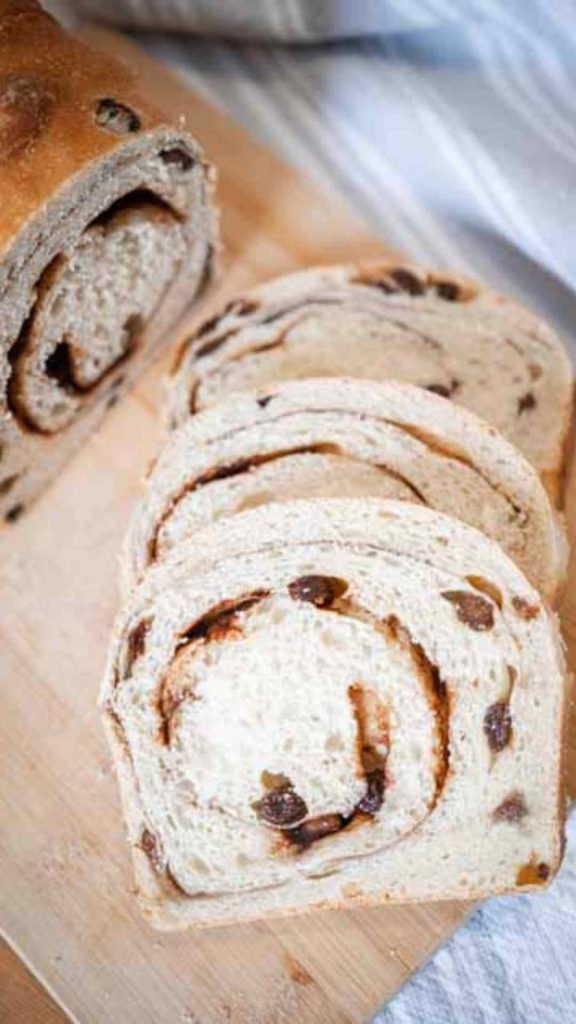

how to store leftover bread
The best way to store your homemade bread is in a plastic bag with a zipper or twist tie. Only slice what you need so that the rest doesn’t dry out. This homemade sourdough cinnamon raisin bread is best within the first few days of baking. Leftovers can be frozen fresh as well!
how to freeze sourdough cinnamon raisin bread
If you will not use the whole loaf of bread in the first few days after baking, it would be best to slice the loaf and freeze. Then take slices out and thaw as you need them.
check out these other sourdough recipes!
- Soft Sourdough Sandwich Bread
- Sourdough Dutch Oven Bread
- Sourdough Rosemary Garlic Bread
- Sourdough Cinnamon Rolls
- Sourdough Buttermilk Biscuits
- Sourdough Discard Scones
- Sourdough Discard Crackers
- Sourdough Pancakes or Waffles
- Sourdough Pie Crust
printable recipe card

Sourdough Cinnamon Raisin Bread
This Sourdough Cinnamon Raisin Bread is an easy, low maintenance sourdough bread recipe that yields the best loaves of a soft sourdough treat. Sweet cinnamon sugar and juicy raisins swirled in soft white bread is super delicious and nostalgic.
Ingredients
Bread Ingredients
- 4 T softened or melted butter
- 1 1/4 cups warm water
- 3/4 cup bubbly and active sourdough starter
- 2 Tablespoons honey or maple syrup
- 2 teaspoons salt
- 4 cups bread flour
- 3/4 cup raisins
Filling Ingredients
- 1/4 cup brown sugar
- 1 Tablespoon cinnamon
Instructions
- In the bowl of a stand mixer, add melted butter, warm water, active sourdough starter. sugar, salt and half of the flour. Mix with the paddle attachment until all of the ingredients are well combined. Add the rest of the flour and the raisins and switch to the dough hook. Knead on low speed for 7-8 minutes, or until the dough is glossy and smooth and passes the windowpane test. The dough should feel soft and slightly sticky, but not too sticky to handle. It will be quite sticky when you first begin kneading, but will become less sticky as it comes together. After 7-8 minutes of kneading, if it is too sticky to handle, add some more flour (just a little bit at a time).
- Put all of the dough into a buttered bowl and cover with plastic wrap or a damp towel. Leave the dough at room temperature overnight or for 10-12 hours. The dough is ready when it has doubled in size.
- The next morning, spread melted butter into a loaf pan. To shape the dough, roll it out into a large rectangle. Stretch the sides as far as you can without breaking or tearing, and press the dough into a long rectangle. Mix the filling ingredients and spread evenly over the rectangle. Then starting at the short end, roll the dough up into a log. Pinch the seam closed. Tuck the ends underneath so only the smooth, round top of the dough iis exposed. Place the dough into a buttered loaf pan seam side down. Cover with a damp towel and let the dough rise again.
- Now the dough needs to rise again. The second rise can take anywhere from 3-6 hours depending on the temperature of your house. If it's warm, it will rise more quickly. The dough is ready to bake when it is about 1 inch above the rim of the pan. Preheat the oven to 375 degrees F.
- Place the loaf pan on the center rack. Bake for 40 minutes. The crust will be golden brown. When the bread is done, turn the loaf out of the loaf pan onto a wire rack. If you want the crust to soften, rub butter onto the crust. For best results, let it cool for at least one hour before slicing.
Recommended Products
As an Amazon Associate and member of other affiliate programs, I earn from qualifying purchases.
pin this recipe for later


